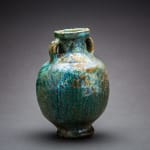Parthian Glazed Terracotta Amphora, 1st Century CE - 3rd Century CE
Glazed Terracotta
height 19.1 cm
height 7 1/2 in
height 7 1/2 in
LO.527
Further images
After the death of Alexander the Great, his expansive empire was divided among three of his most loyal generals, with Seleucis assuming control of the eastern portion. The Seleucid Dynasty...
After the death of Alexander the Great, his expansive empire was divided among three of his most loyal generals, with Seleucis assuming control of the eastern portion. The Seleucid Dynasty was thereby established, following in the footsteps of the Persian, Assyrian, and Babylonian Empires, with its capitals at Antioch (in modern Syria) and Seleucia (in modern Iraq). However, as history has shown, maintaining calm and order over such a large territory, encompassing so many different cultures, proved difficult if not impossible. In 245 B.C., the Parthians revolted against the Seleucids under the leadership of Satrap Andragoras, igniting a civil war that would lead to further autonomy, despite the continued recognition of the Greek kings as their superiors. Although the Parthians had been mentioned in Assyrian text as early as the 7th Century B.C., it was not until the rise of Mithradates I that the yoke of Seleucid control was toss aside and Parthia reached the heights of its glory. Mithradates the Great quickly conquered the lands of Babylon, Media, and Elam, establishing a great empire that would rival Roman dominance and last until 224 A.D. when the Sassanid Empire finally subjugated their lands.
There was considerable regional variation in the types of ceramic vessels produced in Mesopotamia during the Parthian periods. A distinctive feature of Mesopotamian manufacture was the use of blue, green or yellow alkaline glazes. This is a particularly attractive example as the original deep blue colour survives unweathered. The glazes on Parthian pottery form part of a long tradition of alkaline glazing in Mesopotamia. Glazes were made by mixing the ash produced by burning desert plants with crushed quartz pebbles or quartz sand. The blue and green colours are due to the presence of minor amounts of iron oxide, with or without copper.
There was considerable regional variation in the types of ceramic vessels produced in Mesopotamia during the Parthian periods. A distinctive feature of Mesopotamian manufacture was the use of blue, green or yellow alkaline glazes. This is a particularly attractive example as the original deep blue colour survives unweathered. The glazes on Parthian pottery form part of a long tradition of alkaline glazing in Mesopotamia. Glazes were made by mixing the ash produced by burning desert plants with crushed quartz pebbles or quartz sand. The blue and green colours are due to the presence of minor amounts of iron oxide, with or without copper.





